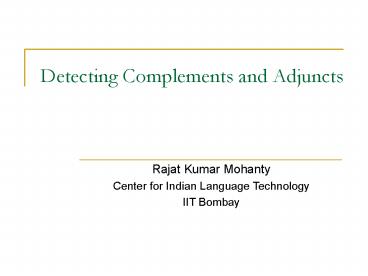Detecting Complements and Adjuncts - PowerPoint PPT Presentation
Title:
Detecting Complements and Adjuncts
Description:
It tells us how words are combined to make phrases and sentences. ... [The journey from Mumbai to Delhi on the Christmas Day] was tiring. ... – PowerPoint PPT presentation
Number of Views:445
Avg rating:3.0/5.0
Title: Detecting Complements and Adjuncts
1
Detecting Complements and Adjuncts
- Rajat Kumar Mohanty
- Center for Indian Language Technology
- IIT Bombay
2
Outline
- X-bar Theory Revisited
- Complement and Adjuncts within an NP
- Detecting Complements and Adjuncts
- Structural Ambiguity
- Phrase Structure Rules for Noun Phrases
- Reordering of Adjuncts
- Co-ordination
- Extraposition
- Preposing
- Co-occurrence Restrictions
- Generalization
- Exercises
3
X-bar Theory
- It tells us how words are combined to make
phrases and sentences. - It captures the commonality between different
types of phrases, which PS-rules cannot.
4
X-bar Projection
XP
(Maximal projection)
(Intermediate projection)
X
YP
X
ZP
(Minimal projection)
5
X-bar Projection
XP
(X-phrase)
YP
X
(Specifier)
X
ZP
(Head)
(Complement)
6
X-bar Projection
XP
X
YP
(Specifier)
ZP
X
(Adjunct)
(Complement)
ZP
(Head)
X
7
X-bar Projection
NP
N
NPspecifier
PPcomplement
Johns
Nhead
solution
to the problem
8
X-bar Projection
NP
N
Detspecifier
the
PPadjunct
N
in the cabinet meeting
PPcomplement
Nhead
of the cricket match
discussion
9
Complement and Adjuncts within an NP
NP
N
Detspecifier
a
PPadjunct
N
with long hair
PPcomplement
Nhead
of NLP
student
10
Structural Ambiguity in an NP
- A student of high moral principles
- Is there any ambiguity in this NP ?
- a person who studies high moral principles
- a student who has high moral principles
- This ambiguity can be characterized in structural
terms
11
a person who studies high moral principles
NP
N
Detspecifier
a
PPcomplement
Nhead
of high moral principles
student
12
a student who has high moral principles
NP
N
Detspecifier
a
PPadjunct
N
of moral principles
Nhead
student
13
Examples
- Arguments with John are often pointless. (???)
- Arguments with few premises are often
pointless. (???) - Arguments with John with few premises are
often pointless. - Arguments with few premises with John are
often pointless.
14
Phrase Structure Rules for Noun Phrases
- The complement must precede an adjunct.
- Rules
- NP? N (PP) adjunct rule
- N? N (PP) complement rule
- Examples
- a student of Physics with long hair
- a student with long hair of Physics
15
Phrase Structure Rules for Noun Phrases
- Adjunct rules are recursive.
- A complement rule is not recursive, i.e., it can
apply only once. - Examples
- a student with long hair with short arms
- a student of Physics of Chemistry
16
Reordering of Adjuncts
- Unlike complements which have to precede
adjuncts, adjuncts can be freely reordered with
respect to each other. - a student with long hair with short arms
- a student with short arms with long hair
17
Co-ordination
- Complements can be co-ordinated with other
complements. - a student of linguistics and of Computer
Science - Adjuncts can be co-ordinated with other adjuncts.
- a student with short arms and with long hair
- But adjunct PPs and complements PPs cannot be
co-ordinated. - a student of Physics and with short arms
- a student with short arms and of Physics
18
Extraposition
- Adjuncts are less tightly bound to the head noun
than complements. - It is possible to extrapose adjuncts PPs but not
possible to extrapose complement PPs. - Examples
- A student with long hair came to see me
yesterday. - ? A student came to see me yesterday with long
hair. - A student came to see me yesterday of Physics.
19
Preposing
- Complements and Adjuncts behave differently with
respect to preposing. - Examples
- What branch of linguistics is John a student
of? - What kind of hair is John a student with?
- Note that Complements and Adjuncts go in opposite
directions with respect to Extraposition and
Preposing. - Heads are more closely related to their
complements than to their adjuncts.
20
Co-occurrence Restrictions
- Heads place significant restrictions (i.e. ,
subcategorisation) on what can appear as their
complement. - a student of NLP
- a boy of NLP
- a girl of NLP
- a teenager of NLP
- No similar restrictions are imposed on adjuncts.
- a student with long hair
- a boy with long hair
- a girl with long hair
- a teenager with long hair
21
Generalization
- Heads are more closely related to their
complements than to their adjuncts. - Subcategorisation restrictions hold only between
a head and its complement, not between a head and
its adjuncts.
22
Exercise-I
- Identify the complements and adjuncts in the
following NPs - your reply to my letter
- the attack on Starr
- the loss of the ship
- Johns disgust at Marys behavior
- his disillusionment with life
- the book on the table
- the advertisement on the television
- the fight after the match
- his resignation because of the scandal
- a cup with a broken handle
23
Exercise-II
- Provide trees for the bracketed NPs in the
following sentences - I met a specialist in fibreoptics from Japan.
- The journey from Mumbai to Delhi on the
Christmas Day was tiring. - The discussion of the riots in the bar was full
and frank. - The solution to the problem given by John is
better than the solution given by Mary. - The solution to last weeks quiz on page 20 is
a better one.
24
Sources and Suggested Readings
- Introduction to Government and Binding Theory,
2nd edn., Liliane Haegeman, Blackwell, 1994. - Syntactic Structures Revisited, Howard Lasnik,
MIT Press, 2000. - Bhatt, R. 2003. Introduction to Syntax.
- Principles and Parameters, Peter Culicover,
Oxford, 1997.
25
THANK YOU

